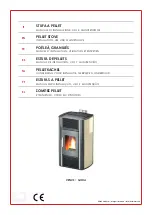
21
WOOD HEAT UTILIZATION
The top down method of
fi
re building is recommended for this appliance. After making sure that the stove air
intake controls are fully open (completely pull-out towards you), Place the largest pieces of wood on the bottom,
laid in parallel and close together. Smaller pieces are placed in a second layer, crossways to the
fi
rst. A third layer
of still smaller pieces is laid crossways to the second, this time with some spaces between. Then a fourth layer of
loose, small kindling and twisted newspaper sheets tops off the pile.
Higher ef
fi
ciencies and lower emissions generally result when burning air dried seasoned hardwoods, as compared
to softwoods or to green or freshly cut hardwoods.
DO NOT BURN:
Burning these materials may result in release of toxic fumes or render the heater ineffective and cause smoke.
Dead wood lying on the forest
fl
oor should be considered wet, and requires full seasoning time. Standing
dead wood can usually be considered to be about 2/3 seasoned. Splitting and stacking wood before it is stored
accelerates drying time. Storing wood on an elevated surface from the ground and under a cover or covered
area from rain or snow also accelerates drying time. A good indicator if wood is ready to burn is to check the
piece ends. If there are cracks radiating in all directions from the center then the wood should be dry enough
to burn. If your wood sizzles in the
fi
re, even though the surface is dry, it may not be fully cured, and should be
seasoned longer
Your furnace was designed to burn wood only; no other materials should be burned. Waste and other
fl
ammable
materials should not be burned in your furnace. DO NOT USE CHEMICALS OR FLUIDS TO START THE FIRE. DO NOT
BURN GARBAGE, GASOLINE, NAPTHA, ENGINE OIL, OR OTHER INAPPROPRIATE MATERIALS. Any type of wood may
be used in your furnace, but speci
fi
c varieties have better energy yields than others. Please consult the following
table in order to make the best possible choice.
1. Garbage;
2. Lawn clippings or yard waste;
3. Materials containing rubber, including tires;
4. Materials containing plastic;
5. Waste petroleum products, paints or paint thinners,
or asphalt products;
6. Materials containing asbestos;
7. Construction or demolition debris;
8. Railroad ties or pressure-treated wood;
9. Manure or animal remains;
10. Salt water driftwood or other previously salt water
saturated materials;
11. Unseasoned wood; or
12. Paper products, cardboard, plywood, or
particleboard. The prohibition against burning
these materials does not prohibit the use of
fi
re
starters made from paper, cardboard, saw dust,
wax and similar substances for the purpose of
starting a
fi
re in an affected wood heater.
Summary of Contents for AF700
Page 10: ...10 CENTRAL INSTALLATION ADD ON INSTALLATION ...
Page 12: ...12 INSTALLATION D INSTALLATION E ...
Page 13: ...13 INSTALLATION H TOP VIEW FRONT VIEW INSTALLATION F INSTALLATION G ...
Page 32: ...32 NOTES ...
Page 33: ...33 NOTES ...
















































